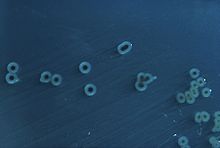Salmonella enterica subsp. enterica: Difference between revisions
→Treatment: moved to Salmonellosis article |
→Epidemiology: added content |
||
| Line 63: | Line 63: | ||
== Epidemiology == |
== Epidemiology == |
||
Invasive strains of non-typhoidal salmonella, such as ''S'' Typhimurium ST313 have recently been labelled as emerging diseases in Africa. Key host immune deficiencies associated with HIV, malaria and malnutrition have contributed to a wide spread of this disease and the need to use expensive antimicrobial drugs in the poorest health services in the world.<ref>{{cite journal|last1=Feasey|first1=Nicholas A.|last2=Dougan|first2=Gordon|last3=Kingsley|first3=Robert A.|last4=Heyderman|first4=Robert S.|last5=Gordon|first5=Melita A.|title=Invasive non-typhoidal salmonella disease: an emerging and neglected tropical disease in Africa|journal=The Lancet|date=2012|volume=379|pages=2489-99}}</ref> |
|||
{{main|Salmonellosis}} |
{{main|Salmonellosis}} |
||
Revision as of 04:56, 24 April 2015
| Salmonella enterica | |
|---|---|

| |
| Salmonella Typhimurium colonies on a Hektoen enteric agar plate | |
| Scientific classification | |
| Kingdom: | |
| Phylum: | |
| Class: | |
| Order: | |
| Family: | |
| Genus: | |
| Species: | |
| Subspecies: | S. e. subsp. enterica
|
| Trinomial name | |
| Salmonella enterica subsp. enterica | |
| Serovar | |
| |
Salmonella enterica subsp. enterica is a subspecies of Salmonella enterica, the rod-shaped, flagellated, aerobic, Gram-negative bacterium. It is a member of the genus Salmonella.[1] Many of the pathogenic serovars of the S. enterica species are in this subspecies, including that responsible for typhoid.[2]
Serovars
S. enterica subsp. enterica contains a large number of serovars which can infect a broad range of vertebrate hosts. The individual members range from being highly host-adapted (only able to infect a narrow range of species) and displaying a broad host range. A number of techniques are currently used to differentiate between serotypes. These include looking for the presence or absence of antigens, phage typing, molecular fingerprinting and biotyping, where serovars are differentiated by which nutrients they are able to ferment. A possible factor in determining the host range of particular serovars is phage-mediated acquisition of a small number of genetic elements that enable infection of a particular host.[3] It is further postulated that serovars which infect a narrow range of species have diverged from ancestors with a broad host range, and have since specialised and lost the ability to infect some hosts.[4]
A selection of serovars, with known hosts listed. Since there are more than 2500 serovars of Salmonella enterica subsp. enterica, this list is incomplete.
| Serovar | Host species |
|---|---|
| Salmonella Choleraesuis | Swine |
| Salmonella Dublin | Cattle |
| Salmonella Enteritidis | Humans, rodents, galliformes |
| Salmonella Gallinarum | Galliformes |
| Salmonella Hadar | Humans, galliformes, rabbits |
| Salmonella Heidelberg | Humans, galliformes, swine[5] |
| Salmonella Infantis | Humans, poultry |
| Salmonella Paratyphi | Humans |
| Salmonella Typhi | Humans |
| Salmonella Typhimurium | Infects humans, cattle, swine, sheep, horses, rodents, galliformes |
Metabolism
Genetic evidence suggests that the serovars can be divided into two groups - one which causes enteric infection and has a broad repertoire of metabolic capabilities, and one which usually causes invasive infection, often in a narrow range of hosts, and shows degradation of anaerobic metabolic pathways. It is thought that these metabolic capabilities are important for obtaining nutrients in the challenging and nutrient-limited inflamed gut environment.[6]
Nomenclature
The serovars can be designated fully or in a shortened form.[7] The short form lists the genus, Salmonella, which is followed by the capitalized and non-italicized serovar. The full designation for Salmonella Typhi is Salmonella enterica subsp. enterica, serovar Typhi. Each serovar can have many strains, as well, which allows for a rapid increase in the total number of antigenically variable bacteria.[8]
Epidemiology
Invasive strains of non-typhoidal salmonella, such as S Typhimurium ST313 have recently been labelled as emerging diseases in Africa. Key host immune deficiencies associated with HIV, malaria and malnutrition have contributed to a wide spread of this disease and the need to use expensive antimicrobial drugs in the poorest health services in the world.[9]
References
- ^ Giannella RA (1996). Salmonella. In: Baron's Medical Microbiology (Barron S et al., eds.) (4th ed.). Univ of Texas Medical Branch. (via NCBI Bookshelf) ISBN 0-9631172-1-1.
- ^ Medical Microbiology (6th ed.). Philadelphia, PA: Mosby Elsevier. 2009. p. 307.
{{cite book}}: Cite uses deprecated parameter|authors=(help) - ^ Rabsch, Wolfgang; Andrews, Helene L.; Kingsley, Robert A.; Prager, Rita; Tschape, Helmut; Adams, Garry; Baumler, Andreas J. (2002). "Salmonella enterica Serotype Typhimurium and Its Host-Adapted Variants". Infection and Immunity. 70 (5): 2249–2255. doi:10.1128/IAI.70.5.2249-2255.2002.
- ^ [www.pnas.org/cgi/doi/10.1073/pnas.1416707112 www.pnas.org/cgi/doi/10.1073/pnas.1416707112].
{{cite journal}}: Check|url=value (help); Cite journal requires|journal=(help); Missing or empty|title=(help) - ^ "Snapshots of Salmonella Serotypes" (PDF). Centers for Disease Control and Prevention. CDC.
- ^ Nuccio, Sean-Paul; Baumler, Andreas (2014). "Comparative Analysis of Salmonella Genomes Identifies a Metabolic Network for Escalating Growth in the Inflamed Gut". mBio. 5 (2): e00929-14. doi:10.1128/mBio.00929-14.
- ^ http://www.bacterio.cict.fr/salmonellanom.html
- ^ http://www.sanger.ac.uk/Projects/Salmonella/
- ^ Feasey, Nicholas A.; Dougan, Gordon; Kingsley, Robert A.; Heyderman, Robert S.; Gordon, Melita A. (2012). "Invasive non-typhoidal salmonella disease: an emerging and neglected tropical disease in Africa". The Lancet. 379: 2489–99.
